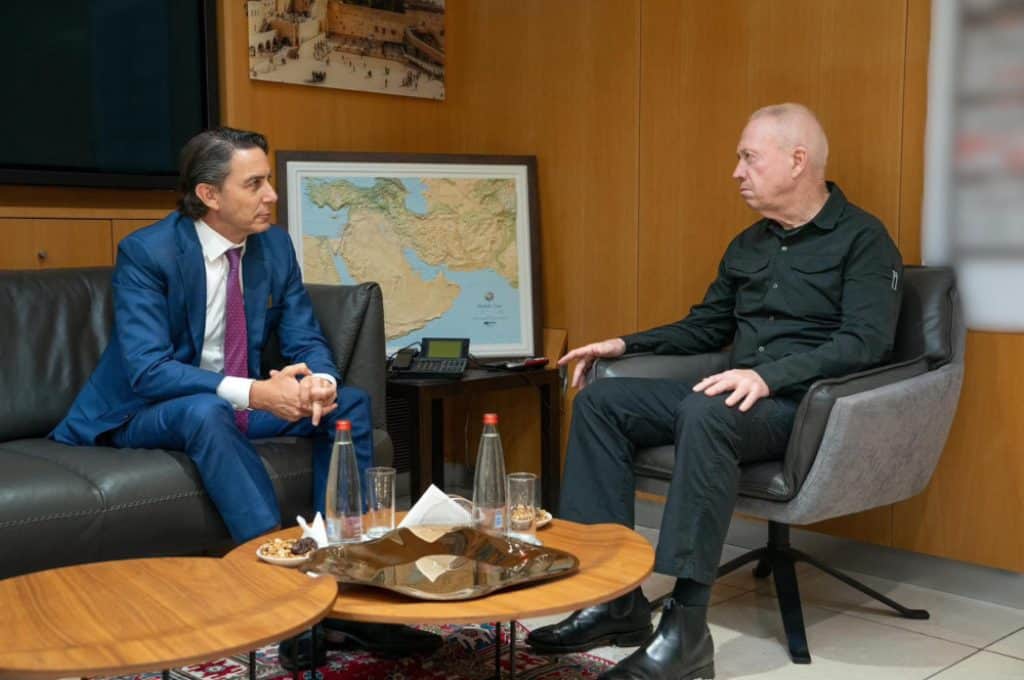
Amos Hochstein, a senior advisor to President Joe Biden, held meetings with Israeli Prime Minister Benjamin Netanyahu and Israeli Minister of Defense Yoav Gallant on September 16. The meetings happened a day after Iranian-backed Houthis in Yemen launched a long-range missile at central Israel. They also came amid rising tensions between Hezbollah and Israel and a push for Israel to launch a military operation to clear the Iranian-backed group from Israel’s northern border.
Netanyahu met with Hochstein in Tel Aviv at the Kirya, the site of Israel’s Ministry of Defense, and discussed Hezbollah’s threat. “The Prime Minister made it very clear that it will not be possible to return our residents without a fundamental change in the security situation in the north,” a statement from Netanyahu’s office noted. Netanyahu said Israel would do what is necessary to protect its security and bring back the 60,000 Israelis who have been evacuated since Hezbollah began its attacks on Israel last October.
Gallant also met with Hochstein, along with US Ambassador to Israel Jack Lew, in a separate meeting at Ministry of Defense Headquarters, according to a statement from his office. Other attendees were Shachar Katz, Gallant’s chief of staff, Brigadier General Guy Markizano, Gallant’s military secretary, and Brigadier General Benny Gal, head of the IDF’s Strategic Division.
The Israeli defense minister highlighted the need for Israel to change the security situation in the north. Gallant briefed Hochstein on the IDF’s current operations and noted that Hezbollah’s refusal to separate itself from the Gaza conflict is forcing Israel to choose expanded military action. “The only way left to ensure the return of Israel’s northern communities to their homes will be via military action,” Gallant’s office noted in a statement about the meeting.
Gallant provided a similar assessment to US Secretary of Defense Lloyd Austin during a call overnight between September 15 and September 16. “The possibility for an agreed framework in the northern arena is running out as Hezbollah continues to ‘tie itself’ to Hamas—the trajectory is clear,” Israel’s defense minister said. Gallant’s statements come as reports indicate that Major General Ori Gordin, head of the IDF’s Northern Command, is also pushing for military action against Hezbollah.
In addition, on September 15, reports noted that an IDF brigade commander had ordered fliers to be dropped on the other side of the border between Metula and Ghajar, warning Lebanese in the area to leave. The move raised eyebrows because Israel has dropped fliers in Gaza to warn civilians to leave before operations have taken place against Hamas. However, the fliers in southern Lebanon were characterized as a local initiative by the IDF’s 769th Brigade—not approved by higher commanders. The unit, which operates in the region of Kiryat Shmona and protects local communities along the front line with Lebanon, is the eastern brigade of the IDF’s 91st Division responsible for securing the border with Lebanon.
The fliers, apparently dropped by a small drone, warned people to leave fields between the Israeli communities of Metula and Ghajar, which are in a disputed area along the border. Hezbollah uses this area to carry out frequent attacks on Metula and other Israeli communities near Kiryat Shmona. For instance, Kibbutz Dan, near Metula, was struck by an anti-tank missile that injured one person on September 11.
An IDF statement issued on the evening of September 16 underpinned the threat posed to Metula from the other side of the border. “[F]ollowing the sirens that sounded at 20:13 in the area of Metula, one projectile was identified crossing from Lebanon into Israeli territory and falling in an open area. No injuries were reported. A hit in a structure in the area was identified. No injuries were reported,” the IDF said.
Hezbollah carried out at least eight rounds of attacks on northern Israel on September 16, spurring alert sirens in the Golan and numerous communities in northern Galilee. Eight rockets were fired at northern Israel in one attack, whereas 10 were fired toward the community of Ramot Naftali, which is in a line of hills near Lebanon. The constant rocket fire and drone attacks illustrate that Hezbollah is not deterred by the increasing rhetoric in Israel calling for a military operation in southern Lebanon.







